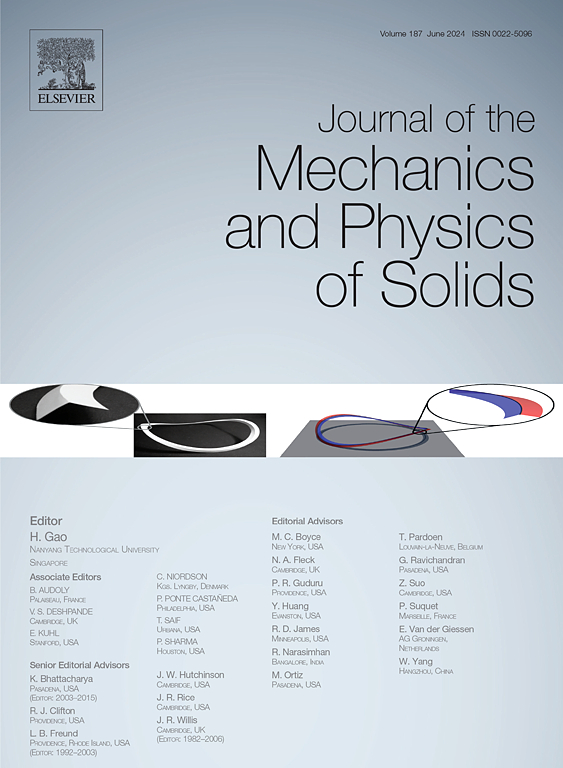Modeling direct and converse flexoelectricity in soft dielectric rods with application to the follower load
IF 5
2区 工程技术
Q2 MATERIALS SCIENCE, MULTIDISCIPLINARY
引用次数: 0
Abstract
Dielectric rods have been employed in various electromechanical applications, including energy harvesters and sensors. This paper develops a general framework to model large deformations in dielectric rods, considering both direct and converse flexoelectric effects. Initially, we derive the governing differential equations for a three-dimensional dielectric continuum solid to model large deformations, incorporating converse flexoelectricity. Then, we derive the equilibrium equations for the flexoelectric strain-gradient special Cosserat rod. Subsequently, we establish its constitutive relations and identify the corresponding work conjugates. To solve these governing differential equations numerically, we implement a quaternion-based numerical approach and obtain flexoelectricity-based solutions corresponding to the follower load. Moreover using these constitutive relations, we have also obtained nonlinear analytical solutions for bending under the follower load that show an excellent agreement with our numerical results. Bending under the follower load is also compared with the transverse load to understand the electric field generation. Unlike, under the application of the transverse load, where the electric field increases monotonically, for the follower load, the electric field gradually switches its sign. The role of direct and converse flexoelectric coefficients has also been examined, and several interesting conclusions have been drawn. Finally, we analyze the effect of mechanical and electrical length scale parameters. The electromechanical response from the follower load can be utilized to fabricate flexoelectric sensors for nanoelectromechanical systems.
软介质杆的正、反挠性电建模,并应用于从动器负载
介电棒已用于各种机电应用,包括能量采集器和传感器。本文发展了一个通用的框架来模拟在介质棒的大变形,同时考虑了直接和反向挠曲电效应。首先,我们推导了三维介质连续体的控制微分方程来模拟大变形,包括反向挠性电。在此基础上,推导了挠曲电应变梯度特殊Cosserat棒的平衡方程。然后,建立了它的本构关系,并确定了相应的功共轭。为了对这些控制微分方程进行数值求解,我们实现了基于四元数的数值方法,并得到了对应于从动器负载的基于柔性电的解。此外,利用这些本构关系,我们还得到了从动件载荷作用下弯曲的非线性解析解,与数值结果非常吻合。并将从动载荷下的弯曲与横向载荷进行了比较,以了解电场的产生情况。与横向负载作用下电场单调增大不同,随动负载作用下电场逐渐变换符号。本文还研究了正挠曲电系数和反挠曲电系数的作用,得出了几个有趣的结论。最后,分析了机械和电气长度尺度参数的影响。从动件负载的机电响应可用于制造纳米机电系统的柔性电传感器。
本文章由计算机程序翻译,如有差异,请以英文原文为准。
求助全文
约1分钟内获得全文
求助全文
来源期刊
CiteScore
9.80
自引率
9.40%
发文量
276
审稿时长
52 days
期刊介绍:
The aim of Journal of The Mechanics and Physics of Solids is to publish research of the highest quality and of lasting significance on the mechanics of solids. The scope is broad, from fundamental concepts in mechanics to the analysis of novel phenomena and applications. Solids are interpreted broadly to include both hard and soft materials as well as natural and synthetic structures. The approach can be theoretical, experimental or computational.This research activity sits within engineering science and the allied areas of applied mathematics, materials science, bio-mechanics, applied physics, and geophysics.
The Journal was founded in 1952 by Rodney Hill, who was its Editor-in-Chief until 1968. The topics of interest to the Journal evolve with developments in the subject but its basic ethos remains the same: to publish research of the highest quality relating to the mechanics of solids. Thus, emphasis is placed on the development of fundamental concepts of mechanics and novel applications of these concepts based on theoretical, experimental or computational approaches, drawing upon the various branches of engineering science and the allied areas within applied mathematics, materials science, structural engineering, applied physics, and geophysics.
The main purpose of the Journal is to foster scientific understanding of the processes of deformation and mechanical failure of all solid materials, both technological and natural, and the connections between these processes and their underlying physical mechanisms. In this sense, the content of the Journal should reflect the current state of the discipline in analysis, experimental observation, and numerical simulation. In the interest of achieving this goal, authors are encouraged to consider the significance of their contributions for the field of mechanics and the implications of their results, in addition to describing the details of their work.

 求助内容:
求助内容: 应助结果提醒方式:
应助结果提醒方式:


